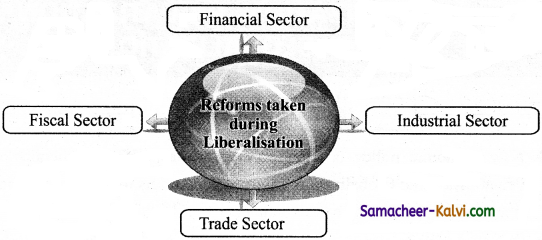Samacheer Kalvi 12th Commerce Notes Chapter 20 Liberalization, Privatization and Globalization
→ New economic policy is commonly known as LPG or Liberalization, Privatization and Globalization. Liberalization refers to laws or rules being liberalized or relaxed by a Government.
→ The Government of India has adopted several measures of Liberalization – for industrial licensing, Freedom of expansion and Production to industries, Foreign exchange reforms and export and import transaction.
→ Impact of Liberalization has opened up new business opportunities abroad and increased foreign direct investment. It became very easy to obtain loans, from banks for business expansion and a number of multinational companies started operating world-wide including India.
→ Privatization is the incidence or process of transferring ownership of a business enterprise, agency or public service from Government to the private sector.
→ Impact of Privatization is to increase the efficiency of Government undertakings, provide better goods and services to the consumers and making way for Foreign Direct Investment (FDI).
→ Globalization means the interaction and integration of the domestic economy with the rest of the world with regard to foreign investment, trade, production and financial matters.
→ Impact of Globalizations is the advent of foreign companies and growth in economy has led to job creation. Multinational corporations can manufacture buy and sell goods worldwide. Globalization has led to boom in consumer product market.
→ Highlights of the LPG Policy is Introduction of new Foreign trade Agreements, Foreign Investment, MRTP Act 1969 (Amended) Deregulation and steps to regulate inflation.

(i) Financial Sector:
Reduce the role of RBI from being a regulator to facilitator Banks were given freedom to generate resources from abroad and within India. Investors like mutual funds, pension funds, merchant banks etc., were allowed to invest in India from 1991.
(ii) Industrial Sector:
It abolished the requirement of licensing except for the following industries, cigrette, defence industries explosive and dangerous chemicals. Expansion of production capacity. Freedom to import capital goods.
(iii) Fiscal Sector:
Fiscal sector reforms include foreign exchange and Foreign Trade policy. Followed by devaluation in 1991 the exchange value of Indian Rupee into international money market was left to free policy of the market force. .
(iv) Trade Sector:
(a) Abolition of import quotas.
(b) Abolition of import licensing except in case of goods which are not environment friendly and are hazardous.
(c) Moderation of import duties and with drawal of export duties. Trade policy after liberalisation is to facilitates integration of the Indian market with the global market to achieving growth through competition rather than protection.